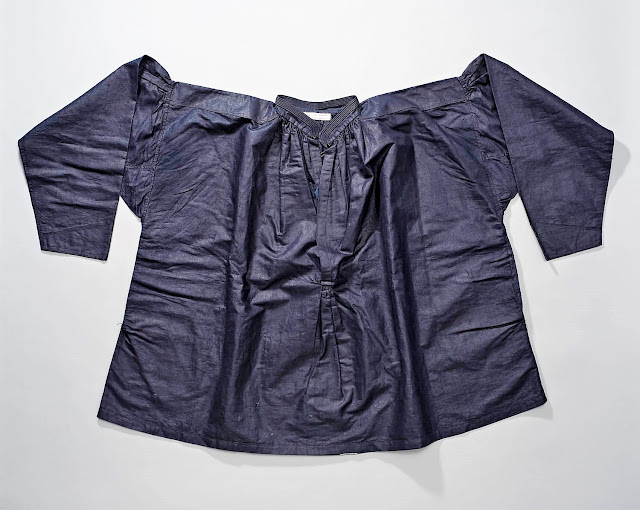Hello all,
Today I will start a new series of the costumes of The Netherlands. They are unique in that they have some folk costumes which are still worn daily. This is not one of them. This costume was worn in the environs of the town of Stein until about 1940. It is also not typical of the Netherlands. Local tradition has it that this costume was influenced by 'settlers from the east'. I have not been able to find any more information about that.
https://nl.wikipedia.org/wiki/Stein_(gemeente)
So that we can locate ourselves, here is the province of Limburg in the Netherlands. The Province of West Limburg in Belgium is immediately adjacent across the border.
Here is the location of the municipality of Stein within Limburg.
This image above is of a painting by the remarkable Dutch artist Jan Duyvetter, who painted many of the Dutch folk costumes. This is of the Sunday Church-going costume of Stein. The Sunday costume consists of a red striped skirt, a silk "mirror" apron, a jacket of a lustrous material, or one woven with a distinct pattern, a 'kashmir' shawl with an ornamented border, a simple linen cap, and a kerchief which matches the shawl. A golden brooch with a cross hanging from it is also worn.
Kerchiefs are rare in Dutch costume, being found only in the Frisian costume of Hindeloopen, and in daily costumes of some other parts of the country.
Here are a couple of photographs of a reconstruction of this costume done in Pella, Iowa. They apparently could not find a kashmir shawl and kerchief, so used upholstery cloth with a paisley pattern. Here you have a better view of the jacket and skirt. You will see that in the first photo she is lighting a candle. The majority of the inhabitants of Stein are Roman Catholic, as are many people in Limburg and North Brabant in general, in contrast to the rest of the Netherlands.
I also found a few old photographs of this costume being worn in the 1940's, on the very valuable website https://geheugen.delpher.nl/nl
It is clear that Jan D. based his painting on this old photograph.
There are also images of jackets and blouses from this town. This first one looks heavy, and has a design woven into the fabric.
This one looks very simple, but is made of a lustrous fabric.
This one is made of black satin, is smocked at the shoulders, and has black lace around the neck.
Under the kerchief, a linen cap was worn on Sundays.
After Church, the kerchief is taken off, and the 'Sunday afternoon cap' is put on. The kashmir shawl is also replaced by a plainer and less expensive shawl.
These types of shawls were [and still are] originally made in Kashmir, where they were embroidered and worn by men. They were highly valued in India. Being hand embroidered made them very expensive. They became all the rage in Europe in the mid 1800s. Copies were soon being made in Paisley, Scotland, and also France. If you look at the photos above, you can see that her shawl and kerchief were very fine.
Here are a couple of photos of the same woman in 'Sunday afternoon dress', with a plainer shawl and a black cap with lace.
The everyday costume was made of less costly materials, but followed the same general lines.
When going out, she would dress up a bit, and would wear the kaper en omslagdoek.
And as in many other Germanic countries, mourning dress was distinctive, there usually being strict rules as to what was to be worn. Here we see the same woman showing us mourning dress. Heavy mourning included a large cloak when going out.
Here are some photos of contemporary costume and dance groups.
Thank you for reading. I hope that you have found this to be interesting and informative.
Roman K.
Source Material:
https://geheugen.delpher.nl/nl
https://www.pinterest.com/katannert65/limburg/stein/
Constance Nieuwhoff et al, 'The Costumes of Holland', Amsterdam, 1985
Jacki Craver et al, 'Dutch Costumes', Pella IA, 2007
























































Truly lovely! I went down the 'memory' rabbit hole after the artist- good thing I didn't have something on the stove because I would have burned it! Thank you as always for the care and the education. Charlotte in California
ReplyDeleteThis comment has been removed by a blog administrator.
ReplyDeletenice post
ReplyDeleteThanks for sharing
Maldives Luxury holiday package
"Exploring Groningen: A Hidden Dutch Gem Beyond Tulips and Windmills" offers an enticing invitation to discover the rich cultural tapestry and lesser-known delights of Groningen, showcasing a side of the Netherlands that extends far beyond its iconic symbols.
ReplyDeleteExploring Groningen
Chocolatier Near Me – Discover a local chocolatier offering exquisite handcrafted chocolate creations. From decadent truffles to luxurious gift boxes, indulge in the finest treats made with passion and premium ingredients. Perfect for any occasion or simply satisfying your sweet cravings.
ReplyDelete"Appreciate the thoughtful analysis here—looking forward to reading more from your blog!"
ReplyDeletematras